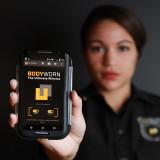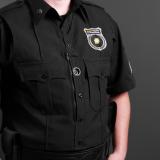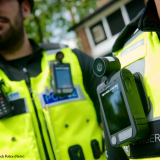Police Body Camera

Image Gallery
In the wake of high-profile police misconduct cases, many communities have embraced police body cameras. Body cameras are small video cameras that clip on to a uniform and record an officer’s contact with the public. These devices hold tremendous potential for encouraging police to interact with citizens in a professional manner and for capturing incidents of misconduct. But officers on the beat observe and interact with hundreds of people every day. Often, they enter private homes and cars, and they interact with victims and innocent bystanders as well as suspects. Police officers themselves also have a right to privacy, and bodycams could make some important parts of their jobs more difficult. The rules governing the use of bodycams should take the privacy of ordinary citizens and the safety of people cooperating with police into account.
CIVIL LIBERTIES CONCERNS
Body cameras may roam through both public and private spaces, capturing large amounts of data about people beyond those interacting with the police officer wearing a camera; after all, the cameras are focused on areas in front of an officer, not on the officer him/herself. If police officers and prosecutors can analyze all this data without restrictions, it may be used for fishing expeditions or for dragnet surveillance using facial recognition software. Similarly, events not relevant to police accountability inquiries may be disclosable under local public records laws, raising concerns about invading personal privacy. Yet, public access to footage relevant to police accountability must also be preserved.
On a technical level, police body cameras are simple and straightforward.
- Usually about the size of a pager, bodycams attach to an officer’s uniform and record video and audio of an officer’s shift. The cameras can clip on to an officer’s lapel, chest pocket, eyewear, or ball cap. Some models include night-vision settings, immediate playback, high resolution, encryption, and other features.
- Data is temporarily stored in the mobile camera and then downloaded at the end of a shift to a law enforcement database. The wearable units time-stamp the feed as events are recorded and store the data in a tamper-proof internal drive. Officers then connect the mobile unit to a docking station at the end of a shift where the data is downloaded to a permanent database for later review and use.
- The amount of data that can be stored in the mobile unit varies. Some models can store up to 12 hours of video, while others can only store around 4 hours of data. Limited storage space means that officers may not be able to record a full shift and instead must select which interactions they record. Selective recording can make these cameras less effective for accountability purposes.
- The usefulness of these devices depends on continuous recording. If officers can turn the equipment on and off at any time, officers engaged in misconduct could skirt accountability while other cops face heightened scrutiny. Policies are needed to ensure that every interaction with the public is recorded so that officers cannot evade recording abuses committed while on duty.
- Nevertheless, constant filming poses a risk to personal privacy. Some recordings inevitably take place inside private homes, e.g., during burglary calls, domestic violence calls, or witness interviews. They might record people taking part in lawful protests. Additionally, police officers interact with people at their worst moments, when behavior may reflect intoxication, mental illness, or just the stress of a difficult situation. Celebrities, ordinary people, and even crime victims captured on police car cameras have seen these moments go viral on YouTube. Bodycams could expose more people to senseless public humiliation.
- Many videos captured by body cameras may be available to the public through public records laws. Although public access to footage is essential to the accountability purposes of body cameras, it may be necessary to limit use and access to non-accountability related videos (by both the public and law enforcement) in order to ensure that there are not needless privacy invasions that result from important public records laws.
Over the past two years, many communities have explored the idea of outfitting patrol officers with bodycams. In August 2013, the federal district court of Manhattan ordered all NYPD patrol officers in certain precincts to fasten bodycams to their uniforms to ensure that they used their “stop and frisk” powers in a professional and evenhanded way. In May 2014, the Washington Post editorial board declared, “Putting cameras on police officers is an idea whose time has come.”
In Washington state, several law enforcement agencies have explored the possibility of strapping cameras to their patrol officers. Seattle, Spokane and Bremerton have initiated pilot programs, and we anticipate widespread use will soon follow.
When government agencies consider acquiring and using surveillance systems, communities and their elected officials must both weigh the benefits against the costs to civil liberties and carefully craft policies and procedures that help to limit the negative effects that surveillance will have on fundamental rights. For a useful list of considerations, please visit the recommendations page.











